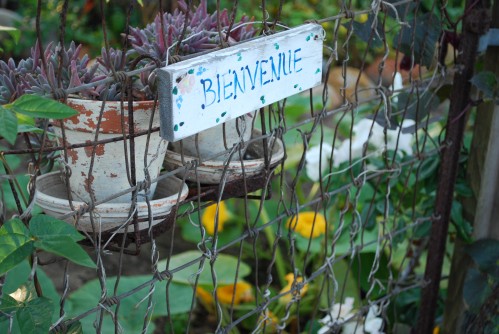 September 4, 2009 marks the one year anniversary of VintageGardenGal, a garden lifestyle blog. Many thanks to those who have visited in the past year, your wonderful comments, and enthusiasm. May those who are drawn to this blog, continue to find valuable information, creative ideas, musings, inspiration to dream, and most important, welcome more garden into your lives.
September 4, 2009 marks the one year anniversary of VintageGardenGal, a garden lifestyle blog. Many thanks to those who have visited in the past year, your wonderful comments, and enthusiasm. May those who are drawn to this blog, continue to find valuable information, creative ideas, musings, inspiration to dream, and most important, welcome more garden into your lives.
A garden is a sanctuary, it is reflective of the person that cares for it. Make sure your garden is "welcoming" to you, your family, your friends, and invited guests. You want your garden to convey a cheery happiness, and an underlying message that it is well taken care of. Here are a few simple suggestions to make a garden welcoming.
Explore color and plant combinations that are visually beautiful, and maybe a surprise to the eye. One of my favorite books for plant combinations, colors, and inspiration to buy for your home library is Shocking Beauty
Create a special spot or garden room that is accessed by a meandering path to a bench under a shady tree. It can be a special spot to rest and gather one's thoughts, even meditate. It can be a spot to entertain and share a glass of lemonade.
Surprise those making footsteps in your garden with a weathered adorable vintage gnome peeking out from under your favorite shrub, or a beautiful garden ornament in a sun-laced clearing. These pieces can be subtle, yet yield a smile.
Scour flea markets and garage sales for time-worn wood buckets or wicker baskets to place in strategic places in the garden to toss a rogue weed or anything deemed for garbage. These pieces will blend in with your garden, and help you to keep your garden tidy.
Think of birds, butterflies, and wildlife in your garden. If your garden is full of songbirds, busy hummingbirds, fluttering butterflies, ladybugs, for instance, it enhances your garden and your time in the garden that much more. Design your garden with plants that attract wildlife. Place birdhouses in your garden. Keep fabulous bird baths, they are garden ornaments in themselves. Keep them clean and full of fresh water. If you have a lot of wildlife in your garden, chances are your garden is healthy and welcoming.
These are a few suggestions that I use in my garden. A welcome garden is a happy garden. What makes your garden welcoming?

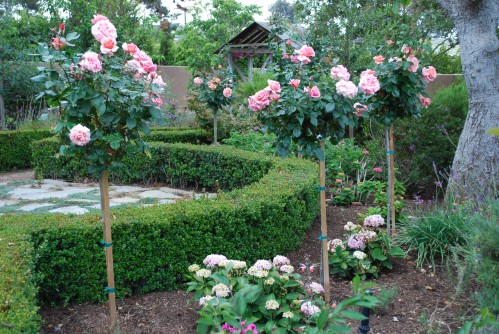 How many of you have heard of
How many of you have heard of  This is a new category first called "Garden Economizing", which will offer you wonderful economic and often ecological tips to save you money in your garden, yet enhancing your garden.
This is a new category first called "Garden Economizing", which will offer you wonderful economic and often ecological tips to save you money in your garden, yet enhancing your garden.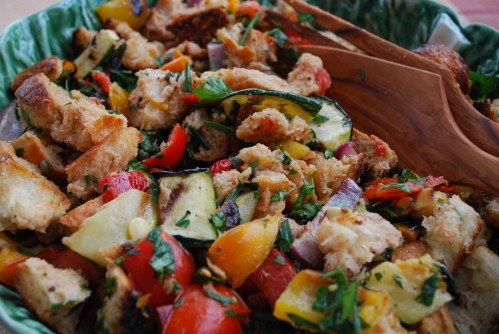 This classic Italian summer panzanella salad oozes with fresh flavors of summer, and takes advantage of your ability to jump in the garden and harvest bell peppers, heirloom tomatoes, fresh assorted herbs, and the last of your summer squash. I usually see panzanella salad with tomatoes, crusty bread, and mozzarella cheese, but like the twist of these added grilled summer vegetables.
This classic Italian summer panzanella salad oozes with fresh flavors of summer, and takes advantage of your ability to jump in the garden and harvest bell peppers, heirloom tomatoes, fresh assorted herbs, and the last of your summer squash. I usually see panzanella salad with tomatoes, crusty bread, and mozzarella cheese, but like the twist of these added grilled summer vegetables.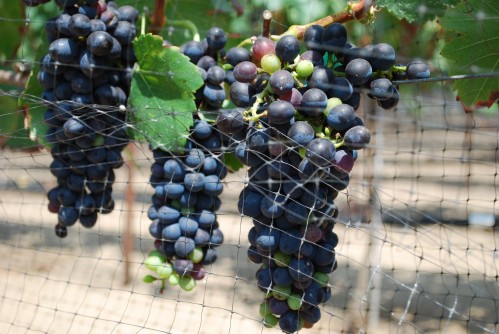 Here at Domaine de Manion, our backyard syrah vineyard, it is late summer and our syrah grapes are showing their true color. Our syrah grapevines have a full vegetative leaf canopy, perfectly formed grape clusters dangle from their shoots, and now the veraison process begins. Veraison is the phenomenon of grapes transitioning in their development from hard to soft in touch, and their color transitions from green to their harvest color, depending on the grape varietal. Syrah, our vineyard grape varietal, is a very dark, inky black color when ripe and at harvest time. In the above photo you can see the color transition happening among the individual grapes.
Here at Domaine de Manion, our backyard syrah vineyard, it is late summer and our syrah grapes are showing their true color. Our syrah grapevines have a full vegetative leaf canopy, perfectly formed grape clusters dangle from their shoots, and now the veraison process begins. Veraison is the phenomenon of grapes transitioning in their development from hard to soft in touch, and their color transitions from green to their harvest color, depending on the grape varietal. Syrah, our vineyard grape varietal, is a very dark, inky black color when ripe and at harvest time. In the above photo you can see the color transition happening among the individual grapes.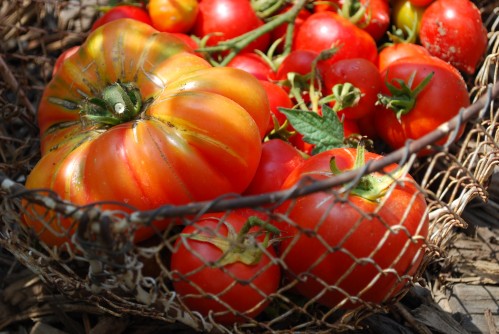 For me, the prize out of our kitchen garden each summer is always heirloom tomatoes. In the spring I plant as many different types as I can, and baby them along through August. I seek out tomato plants I have read about, tomato plants that have funny names, tomato plants that bear certain tomato colors, and even tomato plants with a story behind them.
For me, the prize out of our kitchen garden each summer is always heirloom tomatoes. In the spring I plant as many different types as I can, and baby them along through August. I seek out tomato plants I have read about, tomato plants that have funny names, tomato plants that bear certain tomato colors, and even tomato plants with a story behind them.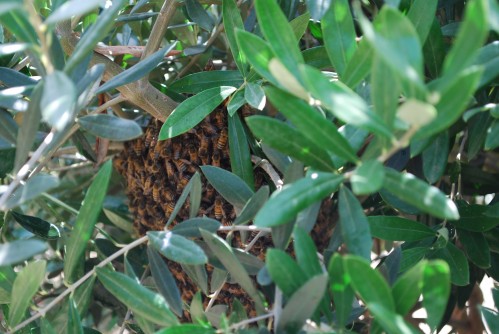 I know that nothing is a coincidence. Just last week I experienced my second honey bee swarming. The first one was in a friend's backyard a few years ago, and the second one was last week, close to our vineyard by the "Little Ollie" olive trees. At first I noticed a tiny dense dark cloud moving above our vineyard, with motion and fervor. Following this sight with my eyes for a while, it dawned on me that it was a swarm of honey bees. Upon further investigation and with the mission to water our "Little Ollie" olive trees, I spotted the swarm, quiet and resting under one of the branches. I wasn't afraid of them, and knew that they would be soon travelling on.
I know that nothing is a coincidence. Just last week I experienced my second honey bee swarming. The first one was in a friend's backyard a few years ago, and the second one was last week, close to our vineyard by the "Little Ollie" olive trees. At first I noticed a tiny dense dark cloud moving above our vineyard, with motion and fervor. Following this sight with my eyes for a while, it dawned on me that it was a swarm of honey bees. Upon further investigation and with the mission to water our "Little Ollie" olive trees, I spotted the swarm, quiet and resting under one of the branches. I wasn't afraid of them, and knew that they would be soon travelling on.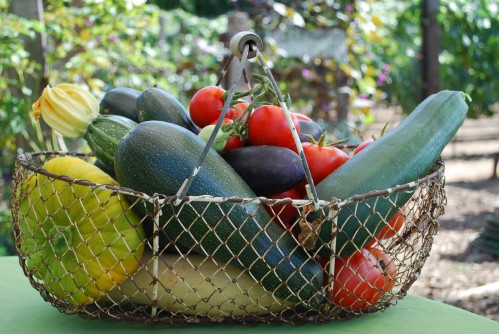 Imagine, it is August, and summer vegetables are at their peak. You are reaping all the benefits of your time invested, and steps taken to ensure a bountiful vegetable harvest. It gives me so much satisfaction to harvest these beautiful and flavorful vegetables.
Imagine, it is August, and summer vegetables are at their peak. You are reaping all the benefits of your time invested, and steps taken to ensure a bountiful vegetable harvest. It gives me so much satisfaction to harvest these beautiful and flavorful vegetables.